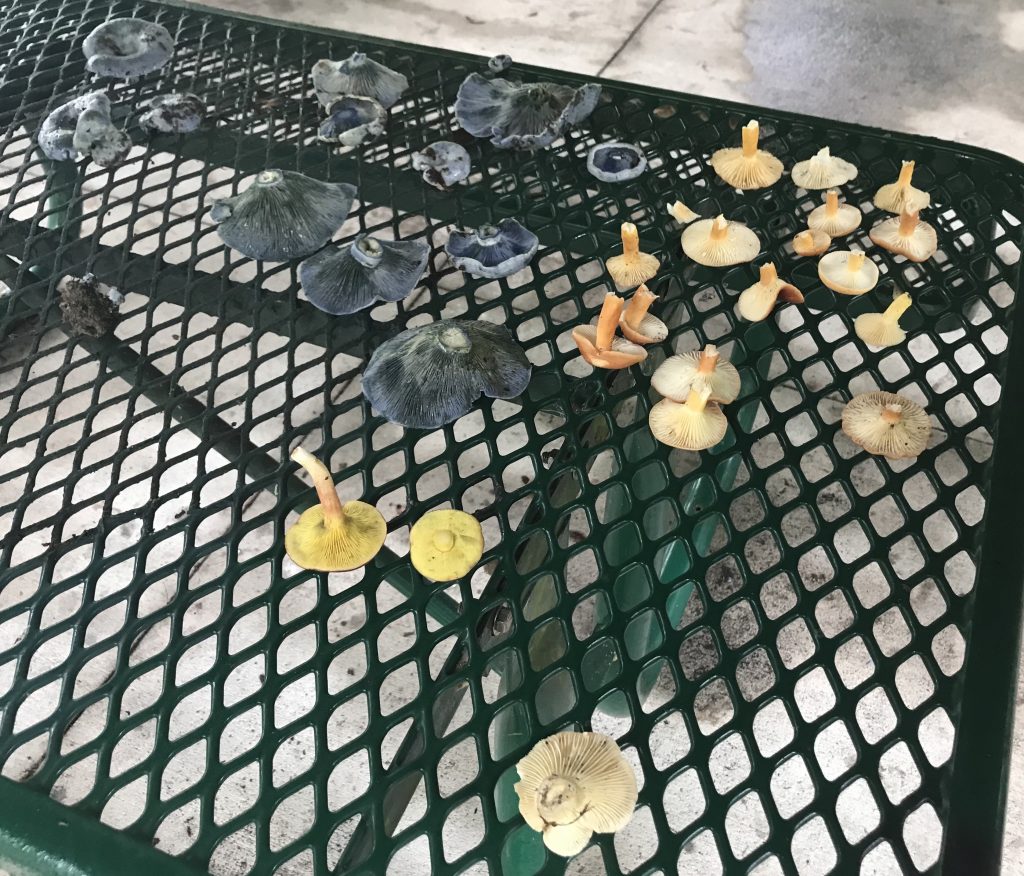
Blue Indigos and Milk Caps in Gainesville. We also saw Chanterelles and Jelly Fungus below. Photo by Green Deane
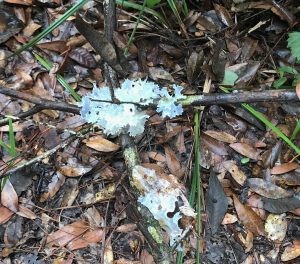
Jelly Fungus. Photo by Green Deane
In real estate it’s location, location, location. This can be also said of plants. Most of them have environmental preferences. Weather is also a factor. Mushrooms, perhaps, represent the extreme: Location, environment, and weather. Most of them need very specific “substrates” such as wood or turf. Every year we wait for the right amount of ground moisture and ground temperature to make them flush. Last year it was in early June, two years ago late July, this year they are only a month late. We saw some chanterelles in Gainesville last weekend along with Blue Indigos and some Jelly Fungus, the later is usually found on above-ground wood with the bark still attached. Hopefully this weekend after Else’s drenching, we will find more locally.
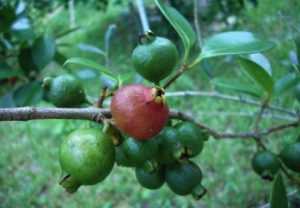
You want pink and green strawberry guava. Photo by Green Deane
Also just beginning to fruit is a species that is very invasive in some areas: The Strawberry Guava. I had one in my yard for about 15 years. Not only are the fruit edible but the dried leaves can be made into a passable tea that also has medicinal qualities. One does, however, need to know a little about the species to make the most of the fruit. It’s a little smaller than a ping-pong ball, has tough seeds, and starts out green and hard. As it ripens and softens it will get shades of pink, yellow and red and eventually become dark red and soft, hence the name “Strawberry Guava.” The fruit is tart and sweet, more tart when young, more sweet when older. Despite the name I never tasted a strawberry flavor in any of the fruit. The problem is unless you spray the tree with insecticides the ripe fruit will be full of fly larvae (which you can also view as free protein.) When the fruit is just starting to turn from green to red the rind is too hard for the flies to lay eggs through. But by the time they are soft and ripe they are prime breeding ground. Thus you have a choice, slightly ripe and tart but grub free, or, very ripe and sweet and squirming. To read more about the Strawberry Guava go here.

Classes are held rain or shine or cold. (Hurricanes are an exception.) Photo by Kelly Fagan.
Foraging Classes this weekend include a rare visit to Ft. Desoto Park, south of St. Pete — there is a park entrance fee — and Mead Garden Sunday in Winter Park. The weekend after next I will be in South Carolina for four classes in Honea Path, see schedule below. That weekend will also a reunion of sorts of five or six first cousins who have never been in the same place, together, at the same time. (We thought we’d do it while we all still alive.)
Saturday July 10th, Ft. Desoto Park, 3500 Pinellas Bayway S. St. Petersburg Fl 33715. There is an entrance fee to the park. Meet at the fishing pier parking lot (which is also where you take the ferry.) It’s a large parking lot, meet near the bathrooms. 9 a.m. to noon. Lots of salt-tolerant species and poison ivy.
Sunday July 11th, Mead Garden: 1500 S. Denning Dr., Winter Park, FL 32789. Meet at the bathrooms. 9 a.m. to noon. Entrance to the bark is on Denning. Some GPS get it wrong.
Saturday July 17th, Classes at 9 a.m. and 1 p.m at Putney Farm, 1624 Taylor Rd, Honea Path, SC 29654. To preregister email me at GreenDeane@gmail.com or putneyfarm@aol.com. Walk-ins welcomed
Sunday July 18th, Classes at 9 a.m. and 1 p.m at Putney Farm, 1624 Taylor Rd, Honea Path, SC 29654. To preregister email me at GreenDeane@gmail.com or putneyfarm@aol.com. Walk-ins welcomed.
For more information, to sign up or prepay, go here.
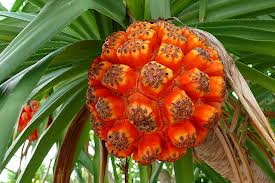
Pandanus Fruit can be edible
The question every time you see one is which species is it? There are some 600 of them in the genus and several are edible one way or another. The ones we see in West Palm Beach sometimes have a little bit of calcium oxalate in the fruit and sometimes doesn’t. So one has to taste it carefully. What you do is take a section, which is a cluster of smaller parts, and chew it. The goal is to get the juice out of it more than anything else though some pulp is edible. Last year this particular growth lightly burned my lips enough to notice but not bothersome. Three species are commonly known as edible: Pandamus amaryllifolius, Pandanus fascicularis, and Pandanus tectorius. The latter is the most consumed of all and it would be a good find. One of the more interesting things about the Pandanus is how it burns when lit. A dried Pandanus stalk can smolder for days like a baseball bat-sized cigarette. It was how some of the Aboriginals of Australia carried fire from one place to another. Among other sighting in the park were Coco-plums and Simpson Stoppers both just starting their seasonal run. The Sea-grapes were still green. They ripen around the first of September. We’re also watching a Camachile tree. The Mahoes were not yet in blossom a lot though we did find a few. They are unusual in that their blossom is yellow in the morning then turn red in the afternoon. Botanist tell us that is to attract different pollinators. The blossoms also have more antioxidants in the afternoon.
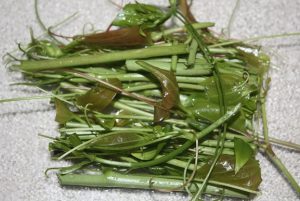
Smilax tips are great in spring. Photo by Green Deane
Smilax has moved into its lesser time of year. Considered by many to be one of the best spring time greens the tips this time of year can be bitter and or peppery. Cooking moderates that. Interestingly Smilax is not a vine, at least not botanically. It is considered a climbing shrub. There are two groups with that classification in Florida, the Smilax and the Nickerbean. Apparently they have multiple trunks and grow about 12 feet long. This qualifies them as a shrub by some thinking. The ripe berries are marginally edible and I have not heard of any non-edible Smilax. That said I don’t eat red-berried Smilax because they are rather singular locally (and it has to have red berries for a reason even if I don’t know it.) I just don’t see Smilax walteri too often so I tend to let it be. There is a different red-berried Smilax species on Crete — S. aspera — and those berries are eaten. S. aspera also has male and female plants. To read more about Smilax go here. Folks also think cactus, like palms, are warm weather residents. In fact, cactus are native to 46 of the 50 US states and naturalized in one of those four (Hawaii.) The only states they are not native in other than Hawaii are Maine, New Hampshire and Vermont — the farthest away from their origin in central America. That said, I knew where there were some surviving cactus behind an old homestead in Maine. They looked quite ratty every spring but somehow managed to survive. Cactus have been naturalized in many parts of the world. Malta comes to mind where they are living fences and a “traditional” source of wine and spirits even though they are native to Mexico and south.

Green Deane videos are now available on a USB.
My nine-DVD set of 135 videos has been phased out and replaced by a 150-video USB. The USB videos are the same videos I have on You Tube. Some people like to have their own copy. The USB videos have to be copied to your computer to play. If you want to order the USB go to the DVD/USB order button on the top right of this page. That will take you to an order form. I’d like to thank all of you who ordered the DVD set over the years which required me to burn over 5,000 DVDs individually.

Green Deane Forum
Want to identify a plant? Perhaps you’re looking for a foraging reference? You might have a UFO, an Unidentified Flowering Object, you want identified. On the Green Deane Forum we — including Green Deane and others from around the world — chat about foraging all year. And it’s not just about warm-weather plants or just North American flora. Many nations share common weeds so there’s a lot to talk. There’s also more than weeds. The reference section has information for foraging around the world. There are also articles on food preservation, and forgotten skills from making bows to fermenting food. 
Your donations to upgrade the EatTheWeeds website and fund a book were appreciated. A book manuscript has been turned it. It had 425 articles, 1326 plants and a third of a million words. What it will be when the publisher is done with it next year is unknown. It will be published in the spring of 2023. Writing it took a significant chunk of time out of my life from which I have still not recovered. (Many things got put off.) The next phase is to update all the content on the website between now and publication date. Also note as it states above the 135-video DVD set has been phased out for 150-video USB. Times and formats change. Which reminds me I need to revisit many plants and make some new videos. This is weekly newsletter #464. If you want to subscribe to this free newsletter you can find the sign-up form in the menu at the top of the page.
To donate to the Green Deane Newsletter click here.


Thanks Dean for the Gainesville Eat the Weeds walk. It was so educational and the chanterelles were DELICIOUS!
I’m glad you liked them. They are a fortunate find particularly before all the rain which should stimulate more.